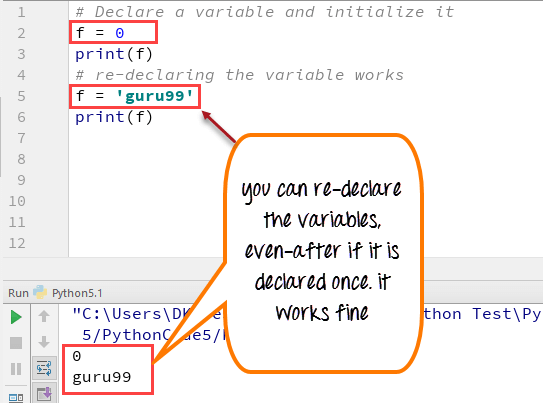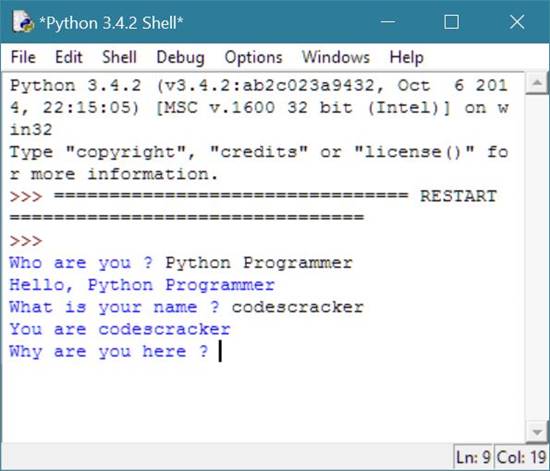Python variables declare variable public define example string programming types declaring assign initialize value print protected private member guru99 class
Table of Contents
Table of Contents
If you’re new to coding in Python, you’re probably wondering how to put quotes around a variable in Python. It’s a common question that many beginners struggle with, but thankfully it’s actually quite simple. In this article, we’ll walk you through the steps needed to put quotes around a variable in Python, and also provide some examples and tips to help you along the way.
Pain Points of Putting Quotes Around a Variable in Python
The process of putting quotes around a variable in Python can be confusing for beginners. This is because Python has several different data types, including strings and integers, which can affect how a variable is interpreted by the program. Additionally, quotes can be used in different contexts within Python, further complicating the matter. Finally, if the user is not familiar with the syntax, it can be easy to accidentally create syntax errors that are difficult to diagnose and correct.
Answering the Target of How To Put Quotes Around A Variable In Python
Putting quotes around a variable in Python entails adding quotation marks to the code. When implementing a string, you will want to include the string within quotation marks. You can use either single (’ ‘) or double (" “) quotes, but it’s important to know that the quotation mark you start with must match the one you end with. This way, Python knows that the characters within the quotes are a string, not a variable name, mathematical operator, or anything else that it could interpret.
Summarizing the Main Points of How To Put Quotes Around A Variable In Python
Understanding how to define strings in Python, using either single or double quotes, is critical for those learning to code in this language. Creating strings, and by extension, putting quotes around variables, is a fundamental building block for more complex programming challenges.
Putting Quotes Around A Variable In Python: A Personal Experience
When I first started learning how to code in Python, I struggled with putting quotes around variables. I was used to other programming languages, where quotes were not always necessary or had stricter rules about how many quotes to use. Python’s somewhat relaxed syntax can be helpful in some cases, but it also took me a while to get used to how to format strings properly. Eventually, I discovered that I could use the backslash (”\") to escape quotes within a string, which made things easier for me.
 Tips for Putting Quotes Around A Variable In Python
Tips for Putting Quotes Around A Variable In Python
One way to ensure that you’re correctly putting quotes around variables in Python is to use an integrated development environment (IDE). IDEs are software programs that provide a more advanced text editor and debugging tools. They can help catch syntax errors before you run your code, saving you time and a lot of frustration. Another thing to remember is that Python is case-sensitive, so be sure to double-check the case of your variables and quotes to avoid syntax issues.
 Using Quotes in Different Contexts
Using Quotes in Different Contexts
In addition to defining a string, quotes can also be used in other contexts within Python. For example, you can use single quotes to define a character, and the output will also utilize single quotes. Additionally, quotes can be used in conditional statements to signify a comparison with a specific value. Understanding how to use quotes in different contexts will improve your programming capabilities and make you a more confident Python coder.
Using Escape Characters
Escape characters are characters that are used to signal that the next character should be treated differently. To input quotes within a string, you can use the backslash escape character. For example, if you want to declare a string with quotes inside it, you can use the backslash before the quote marks to indicate that Python should interpret them as quotation marks and not as the end of the string.
 #### Using String Concatenation
#### Using String Concatenation
String concatenation is the process of combining two or more strings into a single one. It is performed in Python by using the addition operator (+). You can concatenate strings by using the quotes within the same line of code. This is useful when you are creating a string from multiple variables or when other text is needed to be added to the string without breaking or closing the string prematurely.
 Questions and Answers
Questions and Answers
Q: Can you use both single and double quotes for strings in Python?
A: Yes, Python allows the use of single quotes, double quotes, or triple quotes to define a string.
Q: What is the difference between a single quote and a double quote in Python?
A: There is no functional difference between single quotes and double quotes in Python. However, they can be used to avoid escaping the other quote character inside the string. For example, if you need to include a double quote within a string, declare the string with single quotes.
Q: Can you concatenate strings in Python?
A: Yes, strings can be concatenated in Python by using the plus (+) operator. This is often used to combine different strings together to form a more complex one.
Q: Why is it important to put quotes around a variable in Python?
A: Putting quotes around a variable, specifically a string variable, is important because it lets Python know that the content within the quotes should be treated as a string object rather than a variable name, mathematical operator, or other objects that Python can interpret.
Conclusion of Putting Quotes Around A Variable In Python
Putting quotes around a variable in Python may seem like a small task, but it can make a big difference in your code. The ability to properly format strings is a key part of working with Python and is useful in many different scenarios. By understanding the basics of string definition, escape characters, and concatenation, you’ll be able to quickly and confidently create strings that will help you solve programming problems with ease.
Gallery
Python Variables: How To Define/Declare String Variable Types

Photo Credit by: bing.com / python variables declare variable public define example string programming types declaring assign initialize value print protected private member guru99 class
Python Variables

Photo Credit by: bing.com / python variables variable output create fourth enter examples button
Image Print In Python - Imaegus

Photo Credit by: bing.com / pycharm fonction serveur choisir
Python Variables And Assignment - Python

Photo Credit by: bing.com / variables python variable formatted
Find Type Of Variable Python ~ Bookletdesigns

Photo Credit by: bing.com /





